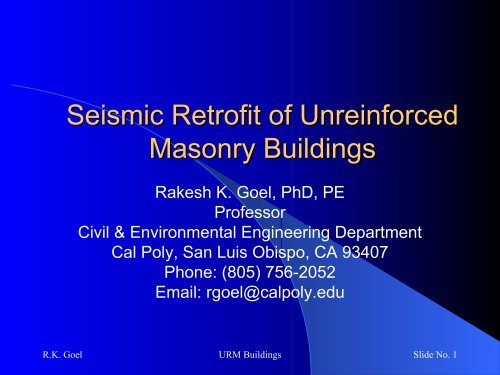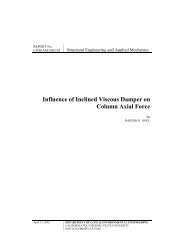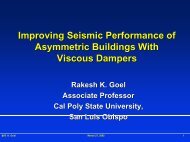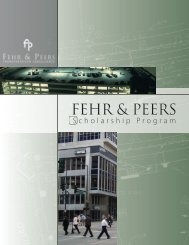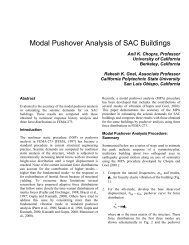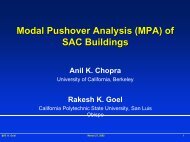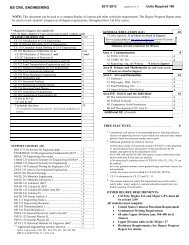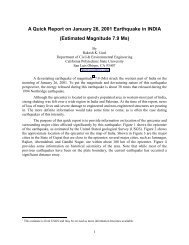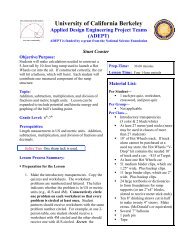Seismic Retrofit of Unreinforced Masonry Buildings - Civil and ...
Seismic Retrofit of Unreinforced Masonry Buildings - Civil and ...
Seismic Retrofit of Unreinforced Masonry Buildings - Civil and ...
You also want an ePaper? Increase the reach of your titles
YUMPU automatically turns print PDFs into web optimized ePapers that Google loves.
<strong>Seismic</strong> <strong>Retr<strong>of</strong>it</strong> <strong>of</strong> <strong>Unreinforced</strong><br />
<strong>Masonry</strong> <strong>Buildings</strong><br />
Rakesh K. Goel, PhD, PE<br />
Pr<strong>of</strong>essor<br />
<strong>Civil</strong> & Environmental Engineering Department<br />
Cal Poly, San Luis Obispo, CA 93407<br />
Phone: (805) 756-2052<br />
Email: rgoel@calpoly.edu<br />
R.K. Goel URM <strong>Buildings</strong> Slide No. 1
Acknowledgement<br />
•Sam Vigil, Cal Poly, SLO<br />
•United State Geological Survey (USGS)<br />
•California Integrated <strong>Seismic</strong> Network<br />
(CISN)<br />
•The Tribune (San Luis Obispo, CA)<br />
R.K. Goel URM <strong>Buildings</strong> Slide No. 2
Outline<br />
•San Simeon earthquake<br />
– Ground motions<br />
– Performance <strong>of</strong> URM buildings<br />
•<strong>Retr<strong>of</strong>it</strong> <strong>of</strong> URM buildings<br />
– Objectives<br />
– Methods<br />
– Cost<br />
R.K. Goel URM <strong>Buildings</strong> Slide No. 3
Prior Earthquake in Vicinity <strong>of</strong><br />
San Simeon<br />
•M 5 to M6 (?) earthquake in 1853<br />
•M 5.7 earthquake in 1906<br />
•M L 6.2 earthquake in 1952<br />
•M w 6.5 earthquake in 2003<br />
•Is there a pattern <strong>of</strong> significant event<br />
about every 50 year?<br />
R.K. Goel URM <strong>Buildings</strong> Slide No. 4
Recorded Accelerations<br />
December 22, 2003 San Simeon Earthquake<br />
Station Name<br />
Station Network Dist. Horiz Apk (g)<br />
No./ID<br />
(km) Ground Struct.<br />
Cambria – Hwy 1 Bridge 37737 CGS 13 .179 - -<br />
San Antonio Dam 36258 CGS 22 .12 .22<br />
Templeton – 1-story Hospital 36695 CGS 38 .483 1.28<br />
Parkfield – Vineyard Canyon 36441 CGS 49 .09 - -<br />
Los Osos – Point Buchon 36427 CGS 52 .09 - -<br />
San Luis Obispo - Rec Ctr 01083 USGS 62 .165 - -<br />
Information: CISN<br />
R.K. Goel URM <strong>Buildings</strong> Slide No. 5
Comparison with Design Code<br />
Information: CISN<br />
R.K. Goel URM <strong>Buildings</strong> Slide No. 6
Performance <strong>of</strong> URM<br />
<strong>Buildings</strong><br />
R.K. Goel URM <strong>Buildings</strong> Slide No. 7
Vulnerability <strong>of</strong> URM <strong>Buildings</strong><br />
• <strong>Unreinforced</strong> masonry buildings suffered the<br />
most damage<br />
– Many such buildings are more than 100 years old<br />
– Not designed for seismic loads<br />
– Lack detailing to transfer seismic forces from<br />
structure to the foundation<br />
• <strong>Unreinforced</strong> masonry buildings have been<br />
known to be seismically vulnerable<br />
– State <strong>and</strong> local codes require retr<strong>of</strong>it but the<br />
deadline was 2008 to 2018<br />
R.K. Goel URM <strong>Buildings</strong> Slide No. 8
• Two-story URM<br />
building built in<br />
1892<br />
• The building<br />
collapsed during<br />
the San Simeon<br />
earthquake killing<br />
two people<br />
Acorn Building<br />
Photo: Paso Robles Chamber <strong>of</strong><br />
Commerce<br />
R.K. Goel URM <strong>Buildings</strong> Slide No. 9
Collapse <strong>of</strong> Acorn Building<br />
Photo: Rakesh Goel<br />
R.K. Goel URM <strong>Buildings</strong> Slide No. 10
Acorn Building<br />
• Ro<strong>of</strong> not tied properly to<br />
the walls<br />
• East-west motion<br />
imposed large<br />
deformations on the<br />
outer wall in second<br />
story leading to its<br />
collapse<br />
• The ro<strong>of</strong> slides to the<br />
side, bends over the<br />
first floor wall, <strong>and</strong><br />
crushes cars <strong>and</strong> two<br />
victims<br />
Sketch: The Tribune (1/24/03), SLO, CA<br />
R.K. Goel URM <strong>Buildings</strong> Slide No. 11
Marlow Interior Building<br />
• Two-story URM<br />
building located on<br />
corner <strong>of</strong> 12 th <strong>and</strong><br />
Park Street<br />
• Large open windows<br />
on street sides <strong>of</strong><br />
the building<br />
• Solid walls with few<br />
openings on other<br />
two sides<br />
Photo: Rakesh Goel<br />
R.K. Goel URM <strong>Buildings</strong> Slide No. 12
Marlow Interior Building<br />
• Significant asymmetry in<br />
building plan<br />
– Torsional (or twisting)<br />
motions in addition to<br />
swaying motions during the<br />
earthquake<br />
• Significant cracks in walls<br />
facing the street sides<br />
– Large dem<strong>and</strong>s on these<br />
walls due to torsion (or<br />
twisting)<br />
Photo: Sam Vigil<br />
R.K. Goel URM <strong>Buildings</strong> Slide No. 13
Bistro Laurent Building<br />
• One-story URM building<br />
• <strong>Retr<strong>of</strong>it</strong>ted by tying ro<strong>of</strong><br />
diaphragm to the walls<br />
• Only minor to moderate<br />
structural damage<br />
– No cracks in the masonry<br />
walls<br />
– Few bricks from the<br />
decorative parapet<br />
separated<br />
Photo: Rakesh Goel<br />
R.K. Goel URM <strong>Buildings</strong> Slide No. 14
Bistro Laurent Building:<br />
<strong>Retr<strong>of</strong>it</strong> Details<br />
Photo: Rakesh Goel<br />
Photo: Rakesh Goel<br />
R.K. Goel URM <strong>Buildings</strong> Slide No. 15
Ali’s Persian Rug Building<br />
• Three-story URM<br />
building built in 1918<br />
• Damage to masonry<br />
façade <strong>and</strong> parapets<br />
– No ties between façade<br />
<strong>and</strong> the main wall<br />
– Bricks peeled due to out<strong>of</strong>-plane<br />
motion <strong>and</strong><br />
stresses imposed on the<br />
joints due to drift<br />
Photo: Sam Vigil<br />
R.K. Goel URM <strong>Buildings</strong> Slide No. 16
Rustic Ranch Gallery<br />
• One-story URM<br />
building s<strong>and</strong>wiched<br />
between two other<br />
buildings<br />
• No structural<br />
damage apparent<br />
except for broken<br />
window glass<br />
Photo: Rakesh Goel<br />
R.K. Goel URM <strong>Buildings</strong> Slide No. 17
Atascadero City Hall<br />
• Reinforced concrete<br />
space frame with<br />
URM façade<br />
• Built in 1918 by<br />
town founder E. G.<br />
Lewis<br />
• Partially retr<strong>of</strong>itted<br />
Photo: Rakesh Goel<br />
R.K. Goel URM <strong>Buildings</strong> Slide No. 18
Atascadero City Hall<br />
Photo: Lew Rosenberg<br />
R.K. Goel URM <strong>Buildings</strong> Slide No. 19
Atascadero City Hall<br />
• Brick façade peeled<br />
<strong>of</strong>f the rotunda<br />
• Moderate cracking<br />
in interior partition<br />
walls<br />
• City Hall closed after<br />
the San Simeon<br />
earthquake<br />
Photo: Rakesh Goel<br />
R.K. Goel URM <strong>Buildings</strong> Slide No. 20
Atascadero City Hall<br />
•<strong>Retr<strong>of</strong>it</strong> prevented parapet collapse<br />
Photo: Rakesh Goel<br />
R.K. Goel URM <strong>Buildings</strong> Slide No. 21
San Luis Obispo (SLO)<br />
• More than 125 URM buildings in the city<br />
• About 25 have been seismically upgraded<br />
• No significant structural damage reported<br />
– Accelerations were about 17%g in SLO compared<br />
to perhaps more than 50%g in Paso Robles<br />
– Performance <strong>of</strong> URM buildings in SLO would not<br />
be significantly different than in Paso Robles if the<br />
shaking in SLO had been stronger<br />
R.K. Goel URM <strong>Buildings</strong> Slide No. 22
Summary<br />
• URM buildings are highly susceptible to<br />
seismic loading<br />
– Potential for collapse<br />
– Significant hazard from falling bricks from façade<br />
• Even basic seismic retr<strong>of</strong>it – tying floor/ro<strong>of</strong><br />
diaphragm to walls – minimized the collapse<br />
potential for URM building<br />
– San Simeon earthquake tested several retr<strong>of</strong>itted<br />
buildings in Paso Robles<br />
– Most retr<strong>of</strong>itted buildings survived without major<br />
damage<br />
R.K. Goel URM <strong>Buildings</strong> Slide No. 23
Summary<br />
• <strong>Buildings</strong> on street corners performed poorly<br />
– Asymmetric in building plan due to large open<br />
windows on street sides<br />
– Torsional motions impose larger dem<strong>and</strong>s on<br />
lateral load resisting elements during earthquake<br />
• <strong>Buildings</strong> at the end <strong>of</strong> the block performed<br />
poorly compared to similar buildings in midblock<br />
– End buildings gets kicked out by neighboring<br />
building<br />
– Need special attention during retr<strong>of</strong>it<br />
R.K. Goel URM <strong>Buildings</strong> Slide No. 24
<strong>Retr<strong>of</strong>it</strong> <strong>of</strong> URM <strong>Buildings</strong><br />
•<strong>Retr<strong>of</strong>it</strong> Objectives<br />
•<strong>Retr<strong>of</strong>it</strong> terminology<br />
•<strong>Retr<strong>of</strong>it</strong> Methods<br />
•Cost<br />
R.K. Goel URM <strong>Buildings</strong> Slide No. 25
<strong>Retr<strong>of</strong>it</strong> Objectives: FEMA-356<br />
• Building Performance Levels<br />
– Collapse prevention<br />
– Life safety<br />
– Immediate occupancy<br />
– Operational<br />
• Earthquake Hazard Level: Probability <strong>of</strong><br />
exceedance in 50 years (Return Period in years)<br />
– 50% (72): Frequent<br />
– 20% (225): Occasional<br />
– 10% ( 475): Rare<br />
– 2% (2,475): Extremely rare<br />
R.K. Goel URM <strong>Buildings</strong> Slide No. 26
<strong>Retr<strong>of</strong>it</strong> Objectives<br />
• Select a combination <strong>of</strong> acceptable level <strong>of</strong><br />
building performance <strong>and</strong> earthquake hazard<br />
– Basic Safety Objectives: Life safety during 10%<br />
<strong>and</strong> collapse prevention during 2% event<br />
– Enhanced Objectives: Basic safety + Better<br />
performance during lower level event<br />
– Limited objectives: Basic safety – Poorer<br />
performance during lower level event<br />
• Higher cost for enhanced performance <strong>and</strong><br />
lower cost for limited performance<br />
R.K. Goel URM <strong>Buildings</strong> Slide No. 27
Terminology<br />
•Rehabilitation<br />
•Repair<br />
•Strengthening<br />
•Upgrading<br />
•<strong>Retr<strong>of</strong>it</strong><br />
– Generic term used for strengthening,<br />
upgrading, repair, or rehabilitation<br />
R.K. Goel URM <strong>Buildings</strong> Slide No. 28
Strengthening or Upgrading<br />
• Technical measures to enhance the<br />
performance <strong>of</strong> an undamaged structure<br />
– Strengthening: Performance <strong>of</strong> the structure did<br />
not satisfy the existing requirements at the time <strong>of</strong><br />
design/construction<br />
– Upgrading: Structure does not meet the new<br />
requirements introduced after the building<br />
construction such as new code provisions<br />
R.K. Goel URM <strong>Buildings</strong> Slide No. 29
Repair or Rehabilitation<br />
•Remedial work to fix the damaged<br />
structure<br />
– Repair: Restoring, but not increasing, the<br />
original performance <strong>of</strong> the structure<br />
– Rehabilitation: Restoration <strong>of</strong> original<br />
geometry <strong>and</strong> performance but also<br />
increasing the strength (or resistance)<br />
R.K. Goel URM <strong>Buildings</strong> Slide No. 30
Terms for URM Building<br />
• Upgrading if undamaged<br />
– Strengthening brings the building only up to the<br />
requirements at the time <strong>of</strong> building’s original<br />
construction<br />
– Strengthening would not satisfy the more stringent<br />
new codes<br />
• Rehabilitation if damaged<br />
– Repair only brings the building back to the original<br />
strength<br />
– Building was damaged because original strength<br />
was not sufficient<br />
R.K. Goel URM <strong>Buildings</strong> Slide No. 31
• Re-pointing<br />
<strong>Retr<strong>of</strong>it</strong> Methods<br />
– Improving the grout condition<br />
– May not be sufficient for seismic retr<strong>of</strong>it<br />
• Epoxy Injection<br />
– Fill minor cracks with epoxy to restore composite<br />
action<br />
• Anchoring & Tying<br />
– Tie the floor/ro<strong>of</strong> to the wall<br />
– Anchor unsupported masonry walls<br />
R.K. Goel URM <strong>Buildings</strong> Slide No. 32
<strong>Retr<strong>of</strong>it</strong> Methods<br />
•Overlays<br />
– High-strength cement mortar ½ inch to 1<br />
inch thick, reinforced with thin steel wire<br />
mesh<br />
– Fiber (Glass or Carbon) Reinforced<br />
Polymers (FRP) layers<br />
•Bracing<br />
– Steel sections, reinforced masonry,<br />
concrete buttress, or FRP strips<br />
R.K. Goel URM <strong>Buildings</strong> Slide No. 33
<strong>Retr<strong>of</strong>it</strong> Methods<br />
• Internal reinforcement<br />
– Steel bars inserted in holes drilled in plane <strong>of</strong> the<br />
URM walls<br />
– Improves in-plane <strong>and</strong> out-<strong>of</strong>-plane flexural<br />
capacity <strong>and</strong> connection between walls/ro<strong>of</strong><br />
• External reinforcement<br />
– Attach reinforcement (steel plates or angles) to the<br />
surface <strong>of</strong> the URM wall<br />
– Improves in-plane <strong>and</strong> out-<strong>of</strong>-plane flexural<br />
capacity<br />
R.K. Goel URM <strong>Buildings</strong> Slide No. 34
• Post-tensioning<br />
<strong>Retr<strong>of</strong>it</strong> Methods<br />
– Used for URM walls that develop tension due to<br />
in-plane or out-<strong>of</strong>-plane bending<br />
– Insert pre-stressing steel to create compression in<br />
the wall<br />
• Base isolation <strong>and</strong> energy dissipation devices<br />
– Used for retr<strong>of</strong>it <strong>of</strong> historical buildings<br />
– Expensive<br />
R.K. Goel URM <strong>Buildings</strong> Slide No. 35
Cost <strong>of</strong> <strong>Seismic</strong> <strong>Retr<strong>of</strong>it</strong><br />
• Higher the rehabilitation objectives, higher the<br />
cost<br />
– Aim for basic safety objectives<br />
– Limited objectives may be acceptable if cost is<br />
prohibitive<br />
• Cost can range from $10 to $100 per square<br />
foot<br />
– Cost can be minimized if seismic retr<strong>of</strong>it work<br />
combined with other upgrades<br />
– Typical cost in SLO has been about $20 per<br />
square foot<br />
R.K. Goel URM <strong>Buildings</strong> Slide No. 36


